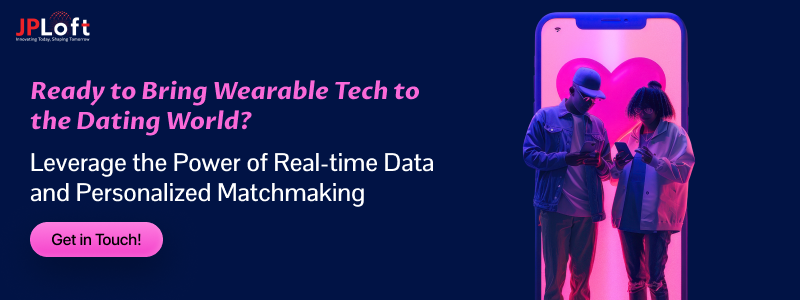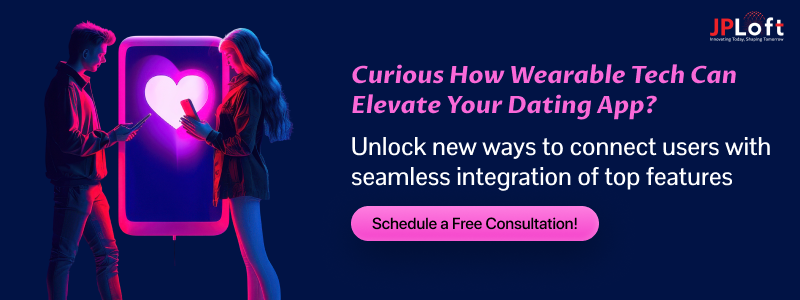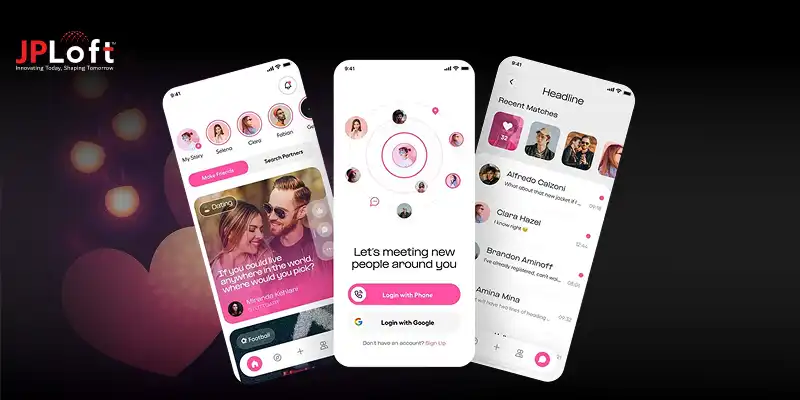Key Takeaways:
Wearables revolutionize dating by using real-time biometric data (activity, stress, sleep) to ensure authentic, lifestyle-aligned, and deeply compatible matches.
The technology offers powerful business benefits: higher user engagement, verified data for better algorithms, and strong premium revenue streams.
Users gain safety features (real-time alerts) and effortless, personalized matching based on actual daily habits, not fake profiles.
Matchmaking advances from profiles to emotional compatibility, linking users based on shared energy levels and biometric-driven lifestyle rhythms.
Key challenges include ensuring data privacy, compliance (GDPR), seamless compatibility across all devices, and maintaining long-term user engagement.
Remember when finding love meant bumping into someone at a coffee shop or getting set up by friends?
Those days feel like ancient history now.
Today, your smartwatch might just be your new wingman. And honestly? It's pretty good at the job.
Wearable tech in dating apps is changing the game in ways we never imagined. We're talking about devices that don't just count your steps or track your sleep- they're actively helping you find meaningful connections.
Your fitness tracker knows when your heart races. Your smartwatch catches those nervous butterflies. And dating apps? They're paying attention.
This isn't science fiction anymore. It's your love life, upgraded.
Let's dive into how these tiny devices strapped to your wrist are making modern romance smarter, safer, and surprisingly more human.
Wearable Tech In Dating Apps Overview
You're probably wearing one right now.
That smartwatch. That fitness band. Maybe even those smart earbuds.
How is wearable tech in dating apps changing the game? Simple—it's making connections feel real before you even meet.
These devices sync with your dating profiles, sharing compatibility data you didn't even know mattered. Your activity levels. Your daily routines. Even your stress patterns.
Think about it.
No more catfishing with fake gym photos. No more pretending you're outdoorsy when you're really a homebody.
Your wearable tells the truth; your profile might embellish.
Dating apps like Fitafy and Sweat already let users match based on actual fitness data from their wearables. Not what you claim to do-what you actually do.
It's authentic matchmaking, powered by the tech already on your wrist.
And if you're wondering how to develop a dating app that stands out in 2025, integrating wearable tech isn't optional anymore-it's essential.
Benefits of Investing in Wearable Tech
Let's talk money. And matches. And why the two go hand-in-hand.
Wearable technology for dating isn't just a cool feature anymore–it's a competitive advantage that's reshaping the entire industry.
Smart investors are watching. Smart entrepreneurs are building. And smart users? They're already swiping with devices that know them better than their exes ever did.
Here's why putting your money into this tech revolution makes perfect business sense.
1. Benefits for Businesses
You don’t just want people to use your app.
You want them to keep coming back.
Wearable tech makes that possible by creating sticky experiences, generating actionable data, and unlocking new monetization models that keep your business thriving.
► Higher User Engagement Rates
When wearable devices in dating sync with your app, users check in constantly.
Their smartwatch buzzes with match notifications, keeping your platform top-of-mind throughout their entire day, not just during lonely evening scrolls.
► Premium Revenue Streams
Impact of wearable tech on dating creates natural upsell opportunities.
Users gladly pay for advanced compatibility algorithms, real-time activity matching, and biometric-based suggestions that actually work- giving you multiple dating app monetization paths beyond basic subscriptions.
► Authentic User Data
Forget self-reported profiles full of aspirational lies. Wearables provide verified data that improves your matching algorithms exponentially.
Better matches mean happier users, lower churn rates, and the kind of success stories that fuel organic growth.
► Market Differentiation
Why wearable tech is important for dating apps? Because your competitors are already exploring it.
When you start an online dating business today, wearable integration isn't futuristic- it's foundational. It's what separates you from another generic swipe-app clone.
2. Benefits for Users
Your users don't care about your business model.
They care about finding someone real.
Someone compatible. Someone who actually matches their lifestyle, not just their carefully curated Instagram aesthetic.
That's where a wearable device for dating apps becomes their secret weapon.
► Verified Compatibility Matching
Wearable tech for dating apps gives users something traditional profiles never could—honesty. Your Fitbit doesn't lie about those 5K runs.
Your Apple Watch won't exaggerate your meditation habits. You match with people based on truth, not fantasy.
► Lifestyle Alignment
Wearable devices in dating apps create matches based on actual daily patterns.
If you're a morning person who hits the gym at 6 AM, you'll match with someone whose device proves they do the same, not someone who claims fitness enthusiasm but hasn't moved in weeks.
► Safety and Peace of Mind
How wearable tech works in dating includes location sharing and real-time safety features. Meeting someone new? Your smartwatch can discreetly alert trusted contacts.
Your device monitors stress levels during dates, giving you an extra layer of security that traditional apps can't provide.
► Effortless Connection
No more endless questionnaires or profile updates.
Your wearable automatically shares relevant compatibility data-your activity preferences, sleep schedule, and even your heart rate variability that indicates stress patterns.
Finding compatible matches becomes passive, not exhausting.
That's the promise wearable tech delivers and why users are demanding it from every dating platform they download.
What is the Role of Wearable Tech in Dating Apps?
So, you’re probably wondering, what is the role of wearable tech in dating apps? Well, it’s not just about tracking your steps or monitoring your heart rate.
Wearable technology for dating is all about giving you a deeper, more personalized experience. It brings real-time data into the mix, making matchmaking smarter and more intuitive.
Let’s break down exactly how wearable devices in dating apps are changing the game:
1. Smarter Matchmaking
With wearable tech, dating apps can match you based on more than just your profile information.
By analyzing real-time data like your fitness levels or sleep patterns, these apps use sophisticated AI in dating apps to suggest matches who align with your actual lifestyle and habits, not just your stated preferences.
2. Better Understanding of Compatibility
Think about it your wearable can track things like stress levels and heart rate. When your app integrates this data, it can suggest matches with similar emotional responses or energy levels.
It’s about going beyond surface-level compatibility and looking at how your body actually reacts in different situations.
3. Real-Time Data for Authentic Connections
Gone are the days of relying solely on static profiles. Wearable tech adds a dynamic layer to dating apps.
Real-time data from your wearable device can show potential matches how active you are, whether you’re in a good mood, or if you’re up for a spontaneous adventure.
4. More Engaging User Experience
Imagine the excitement when your app knows exactly when you're feeling energetic and suggests a hiking date or a dance class!
Wearable tech in online dating apps opens up new ways for you to connect with potential matches in real-time, making every interaction more exciting and authentic.
5. Health and Wellness Compatibility
One of the coolest things about wearable devices in dating apps is how they can match you based on shared health and wellness goals.
Whether it’s running, yoga, or just daily steps, your wearable tech can help find someone who’s on the same fitness journey, making dates more fun and aligned.
6. Increased Safety Features
Safety is a big deal in dating, and wearables can play a role here too. Some apps use your wearable device to check in on your location during dates.
If anything feels off, emergency alerts can be triggered, offering an extra layer of security. Your health and safety are always a priority.
7. Personalized Date Ideas
Thanks to wearable tech, your dating app can recommend activities that match your current mood or health stats.
Not only does this make your dates more enjoyable, but it also helps build a deeper connection.
Imagine a date planned around your current activity levels, ensuring you both have a great time.
8. Long-Term Relationship Insights
Looking ahead, the future of dating apps with technology looks promising. Wearable tech will continue to gather data to help maintain healthy relationships.
Over time, it can offer insights on how you and your partner are evolving, making your connection even stronger. It’s like having a dating coach right on your wrist.
So, if you’re a dating app creator or an investor looking at the future of wearable tech in dating, now’s the time to embrace these advancements.
How to Implement Wearable Tech in Your Dating App?
Wondering how to implement wearable tech in dating apps? It’s a process that involves integrating wearable devices, syncing real-time data, and enhancing user experiences with smart features.
The good news is that while it might sound complex, breaking it down into manageable steps can help make it a seamless and effective integration.
Let’s dive into the essential steps:
Step 1. Understand the Data You Want to Collect
Before you dive into coding and tech solutions, it’s important to understand what kind of data you want your dating app to gather from wearable tech. Wearables can track a variety of metrics such as:
-
Physical data: steps, heart rate, activity levels, and sleep patterns.
-
Emotional data: stress levels, heart rate variability, and energy levels.
-
Location data: where your users are, which can be used for suggesting local dates or matching based on proximity.
By defining what data matters most for wearable technology in dating apps, you can tailor the user experience accordingly. This data forms the backbone of how your app will suggest potential matches and personalize interactions.
Step 2. Choose the Right Wearable Devices to Integrate
Not all wearable devices are the same, so choosing the right ones is key to ensuring smooth integration with your dating app.
Some of the most popular wearable devices include:
-
Smartwatches (e.g., Apple Watch, Samsung Galaxy Watch)
-
Fitness trackers (e.g., Fitbit, Garmin)
-
Health-focused wearables (e.g., Oura Ring)
Make sure to choose devices that are widely used and have reliable APIs (Application Programming Interfaces) for easy integration. You can also look into developing partnerships with popular wearable tech brands to ensure compatibility.
Step 3. Develop a Wearable Tech API Integration
Once you know what data you want to collect and the wearable devices you’ll support, it’s time to implement API integrations. These APIs will allow your dating app to sync with wearable devices, sending real-time data from the device directly to your app.
This complex task often requires the specialized skills of an AI app development company to ensure not only seamless data flow but also the intelligent algorithms needed to interpret the biometric data effectively.
-
Choose the right APIs: Use platforms like Apple HealthKit or Google Fit to access health data such as steps, heart rate, and sleep patterns.
-
Ensure real-time syncing: APIs enable continuous updates, allowing users to share key health metrics instantly with your app.
-
Prioritize security: Implement encryption to securely transfer sensitive data between the wearable devices and your app.
-
Collaborate with skilled developers: Hire dating app developers to ensure smooth integration and seamless data flow between devices and your app.
This process ensures a secure, streamlined experience for users, enhancing the value of wearable tech in dating apps.
Step 4. Ensure Data Privacy and Security Compliance
With the integration of wearable tech, you’ll be handling sensitive health and personal data. This makes data privacy and security an absolute priority. It’s essential to:
-
Obtain user consent: Ensure users are aware of what data you’re collecting and how it’s being used.
-
Encrypt sensitive data: Use encryption to protect users’ personal health data.
-
Comply with regulations: Familiarize yourself with privacy laws like GDPR (General Data Protection Regulation) or HIPAA (Health Insurance Portability and Accountability Act) if applicable to your region.
These steps will help build trust with your users and ensure that your app remains compliant with legal standards.
Step 5. Use the Collected Data for Smart Matchmaking
Now comes the fun part: using all that data to enhance your app’s matchmaking algorithms. For instance:
-
Personalized matching: Use fitness levels, sleep patterns, or activity preferences to match users with similar habits.
-
Emotional compatibility: Integrate emotional data like heart rate variability or stress levels to recommend matches who have a similar emotional rhythm.
-
Proximity-based matching: Leverage location data to suggest nearby matches for spontaneous or location-based dates.
This data-driven approach will make your matchmaking more accurate, personalized, and engaging, helping users connect on a deeper level. Wearable tech in dating apps elevates the experience beyond just a profile and a picture.
Step 6. Implement Real-Time Notifications and Insights
One of the coolest features of wearable devices in dating is their ability to provide real-time feedback.
This can be used in your app in various ways:
-
Health-based notifications: For example, if two users are planning an active date like hiking, your app can send a reminder based on their current activity levels, like, “Your energy levels are perfect for a hike today!”
-
Mood-based suggestions: If a user’s wearable device detects stress or low energy, your app can suggest low-key activities or even send a reminder to relax and recharge.
This real-time data allows your app to provide smarter, more timely suggestions, creating a more interactive experience that builds deeper connections between users.
Step 7. Testing and Optimizing User Experience
After implementing wearable tech, app testing is critical.
You’ll need to test how the wearable tech integrates with your app, ensuring that all data syncs correctly and that the app performs smoothly across various devices.
Focus on these areas during testing:
-
Data synchronization: Make sure data flows seamlessly between the wearable devices and your app without any delays or errors.
-
User interface (UI): Ensure that the data displayed on the app is easy to read and meaningful to the user.
- User feedback: Ask early users to provide feedback on the wearable features and how they’re improving their experience.
Continuous optimization will help you create an app that not only works well but also evolves with your users’ needs.
Step 8. Scale and Expand Features Based on User Behavior
Once your wearable tech in dating apps is up and running, it’s time to look at user behavior and feedback to guide future updates. For example, if users are actively using the fitness-based features, consider adding new activities or expanding data points like sleep quality or heart rate variability.
You can also introduce new features like:
-
Virtual fitness challenges between matches.
-
Wearable-enabled virtual dates for users to meet up based on health data.
By staying ahead of trends and continually improving your app, you’ll ensure that users keep coming back for more.
Cost of Implementing Wearable Tech in Dating Apps
The dating app development cost for integrating wearable tech can vary significantly depending on the complexity of the features you want to offer.
Integrating APIs like Apple HealthKit or Google Fit may not be as costly upfront, typically ranging from $3,000 to $6,000.
However, developing custom features like real-time data syncing, advanced security measures, and intuitive user interfaces can quickly increase the price, with costs ranging from $15,000 to $40,000.
Moreover, you’ll need to budget for ongoing maintenance, updates, and ensuring compatibility with new wearable devices that continuously hit the market.
Ongoing maintenance can cost around $3,000 to $7,000 per month. Properly assessing these costs early on will help you avoid unexpected expenses and ensure your app provides a seamless, high-quality experience for users without breaking the bank.
|
Cost Factor |
Estimated Cost |
Details |
|
API Integration |
$2,000 - $5,000 |
Includes integration with Apple HealthKit or Google Fit. |
|
Custom Feature Development |
$10,000 - $30,000 |
For real-time syncing, personalized dashboards, and additional features. |
|
Security and Data Protection |
$5,000 - $10,000 |
Ensuring encrypted data transfer and privacy compliance. |
|
Ongoing Maintenance |
$2,000 - $5,000/month |
Regular updates, bug fixes, and compatibility checks with new devices. |
Challenges in the Adoption of Wearable Tech in Online Dating Apps
When you think about wearable technology for dating, it sounds exciting, right? The idea of integrating heart rate, steps, and sleep patterns to match people based on real-time data is groundbreaking.
But as with any new technology, integrating wearable devices in dating apps comes with its own set of challenges.
From technical hurdles to user adoption, these challenges can slow down progress if not handled properly.
Let’s dive into some of the challenges in developing a dating app with wearable integration and how to overcome them:
Challenge 1: Compatibility with Multiple Wearables
One of the biggest challenges when integrating wearables in dating apps is ensuring that your app works seamlessly with a variety of wearable devices.
With so many different brands and models out there Apple Watches, Fitbit, Garmin, etc. making sure your app integrates well with all of them can be tricky.
Solution: Focus on popular, widely-used devices like Apple HealthKit and Google Fit for initial integration.
These platforms have broad, compatibility and are widely accepted, helping your dating app with wearable integration reach a larger audience. You can then expand to support niche devices based on user feedback.
Challenge 2: Data Privacy Concerns
Health and fitness data is deeply personal. Ensuring this data remains private and secure is a huge concern, especially with varying regional regulations.
Partnering with a mobile app development company in the USA ensures built-in compliance with frameworks like CCPA, providing a significant trust advantage for users in that market.
Solution: Invest in strong encryption, and make data protection a core aspect of your app. Be transparent about what data you’re collecting and how you’re using it.
Compliance with GDPR and other privacy regulations is key to gaining users' trust. A dating app with wearable integration should feel like a safe space for personal data.
Challenge 3: Real-Time Data Syncing Issues
Imagine this: your app users are expecting real-time syncing between their wearables and your app, but the data flow is delayed or inaccurate.
This could be a huge turn-off for users looking for a smooth experience.
Solution: Make sure your wearable technology integration in dating apps supports seamless, real-time syncing. Work with experienced mobile app development companies to minimize delays and ensure data is updated consistently.
Frequent testing and optimization will help you keep everything running smoothly, allowing users to fully enjoy their experience.
Challenge 4: User Engagement and Adoption
Some users may find the idea of syncing their wearable device with a dating app a bit too much. They may not see the value or might be worried about sharing personal data. Getting them on board can be a challenge.
Solution: Make the benefits clear. Focus on how wearable tech in dating apps makes matchmaking more accurate and personalized.
Show how syncing health data can lead to better match suggestions based on lifestyle compatibility.
Offering features like fitness challenges, mood-based suggestions, or activity-based dates will make the integration feel more valuable.
Challenge 5: Keeping Users Engaged Long-Term
While the novelty of wearables might excite users initially, keeping them engaged long-term can be a challenge.
You need to continually provide value through the wearable technology for dating to maintain interest.
Solution: Introduce fun, gamified elements like progress tracking, fitness challenges between matches, or personalized date ideas based on wearables data.
Keep the app evolving with new features that leverage the data collected, ensuring users see continuous value from wearable technology integration in dating apps.
Challenge 6: User Interface and Experience
Not every user is a tech expert, and navigating through complex data and statistics can be overwhelming.
A poor user interface (UI) can make your dating app with wearable integration feel clunky and difficult to use.
Solution: Keep it simple! When it comes to dating app design, focus on creating an intuitive, easy-to-navigate UI that presents health and fitness data in a way that's both user-friendly and fun.
Instead of overwhelming users with charts, show them how the data directly impacts their matchmaking or date suggestions. The goal is to make their wearable experience feel seamless and engaging, not like another chore.
Challenge 7: Battery Life and Device Limitations
Wearable devices like smartwatches can be power-hungry, and syncing them with your app might lead to rapid battery drain. This can discourage users from keeping their devices connected to your app consistently.
Solution: Optimize how often your app syncs with wearables. Allow users to control the frequency of data updates and provide energy-saving options.
This will make it easier for users to keep their devices connected without worrying about battery life.
Future of Wearable Tech in Dating Apps
Right now, we're just scratching the surface.
Today's wearable dating devices track your steps and share your workout schedule. Pretty basic stuff, right?
But tomorrow? That's where things get wild.
Future trends of dating apps point toward emotional intelligence integration. Imagine wearables that detect your mood through biometric data and suggest matches when you're most open to connection. Or devices that analyze conversation patterns during video dates, giving real-time compatibility scores.
Wearable tech for dating is heading toward predictive matching. Your device will learn your patterns over months: what makes your heart race, what calms you down, who you naturally vibe with and proactively suggest matches before you even start swiping.
We're talking AR glasses that overlay compatibility data in real-world settings. Smart rings that vibrate when you're near a potential match at a coffee shop.
Dating app with wearable integration won't be a feature, it'll be the entire experience.
The question isn't if this technology will dominate dating.
It's whether you'll be ready when it does.
How JPLoft Can Help You Integrate Wearable Tech Seamlessly?
You've got the vision.
The million-dollar dating app idea that integrates wearables perfectly. The concept that'll make Tinder look outdated.
But here's the problem: building it isn't easy.
Syncing smartwatches, fitness trackers, and biometric data requires serious technical expertise. One wrong move and you're dealing with privacy nightmares, buggy integrations, and users who bail after day one.
That's where JPLoft comes in.
As a leading dating app development company, we've mastered the art of wearable integration. We don't just slap on a fitness tracker connection and call it done.
We build seamless ecosystems where your app and wearable devices work as one unified experience.
From Apple Watch compatibility to Fitbit synchronization, we handle the complex backend while you focus on growing your user base.
Your competitors are still figuring out basic swipe features.
You'll be offering biometric matchmaking.
That's the JPLoft difference.
Conclusion
The dating game has changed forever.
And if you're still building apps without wearable integration, you're already behind.
Why wearable tech is important for dating apps comes down to one simple truth: people want real connections, not filtered fantasies.
They're tired of profiles that lie. Tired of matches that ghost. Tired of wasting time on people who don't actually fit their lifestyle.
Wearables solve all of that.
They bring authenticity to an industry drowning in fake profiles. They create matches based on actual behavior, not aspirational bios. They make dating smarter, safer, and infinitely more personal.
The technology exists. The users are ready. The market is exploding.
The only question left is: will you build the future of dating, or watch someone else do it?
Your move. Ready to revolutionize romance? Let's build something extraordinary together.
FAQs
Wearable tech in dating apps refers to integrating devices like smartwatches, fitness trackers, or smart rings with dating platforms. These devices collect real-time data such as heart rate, activity levels, and sleep patterns to improve matchmaking and provide personalized user experiences.
By syncing data from wearable devices, dating apps can suggest matches based on real activity, lifestyle habits, and emotional compatibility. This ensures more authentic connections compared to relying solely on static profile information.
Yes, apps can implement robust security measures, including encryption, GDPR or HIPAA compliance, and AI-powered identity verification to protect sensitive health and personal data. Users have control over what data they share.
Absolutely. Real-time notifications, activity-based match suggestions, and fitness challenges keep users engaged daily. The wearable sync ensures continuous interaction with the app, increasing retention and user satisfaction.
The cost varies depending on the complexity of features. Basic API integration with devices like Apple HealthKit or Google Fit can cost $3,000–$6,000, while custom features, real-time syncing, and advanced security measures can raise the total cost to $15,000–$40,000.













Share this blog